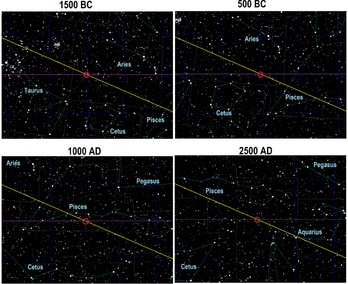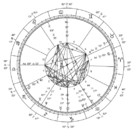Unsolved:Sidereal and tropical astrology
| Astrology |
|---|
| Background |
| Traditions |
| Branches |
Sidereal and tropical are terms used to describe two different definitions of a year. In astrology, they refer to two different systems of ecliptic coordinates used to divide the ecliptic into twelve "signs". Each sign is divided into 30 degrees, making a total of 360 degrees.[1]
While sidereal systems of astrology define the signs relative to the apparent backwards movement of fixed stars of about 1 degree every 72 years from the perspective of the Earth, tropical systems define 0 degrees of Aries to coincide with the vernal point or vernal equinox (also known as the March equinox in the Northern hemisphere), and define the rest of the zodiac from this point.[2][3][4] Sidereal astrology maintains the alignment between signs and constellations via corrective systems known as ayanamsas (Sanskrit: 'ayana' "movement" + 'aṃśa' "component"), to allow for the observed precession of equinoxes, whereas tropical astrology ignores precession.[3][5] This has caused the two systems, which were aligned around 2,000 years ago, to drift apart over the centuries.[2][3][5]
Ayanamsa systems used in Hindu astrology (also known as Vedic astrology) include the Lahiri ayanamsa and the Raman ayanamsa.[6] The Fagan-Bradley ayanamsa is an example of an ayanamsa system used in Western sidereal astrology.[6] As of 2020, sun signs calculated using the Sri Yukteswar ayanamsa were around 23 degrees behind tropical sun signs.[5] Per these calculations, persons born between March 12 - April 12, for instance, would have the sun sign of Pisces.[5] By contrast, persons born between March 21 - April 19 would have the sun sign of Aries per tropical calculations.[7]
Cyril Fagan, a Western sidereal astrologer, assumed the origin of the zodiac to be based on a major conjunction that occurred in 786 BC when the vernal equinox lay somewhere in mid-Aries[8] corresponding to a difference of some 39 degrees or days.

Astronomic zodiac
The dates the Sun passes through the 12 astronomical constellations of the ecliptic are listed below, accurate to the year 2011. The dates will progress by an increment of one day every 70.5 years. The corresponding tropical and sidereal dates are given as well. Template:Sidereal and tropical zodiac dates
See also
- Great year
- Astrology and science
- Synoptical astrology
References
- ↑ "The Tropical, Sidereal & Constellational Zodiacs: the Power of World View". https://www.renaissanceastrology.com/zodiacworldview.html.
- ↑ Jump up to: 2.0 2.1 Subramanian, Vijaya. "Sidereal and Tropical Zodiac – Vijaya Jyoti" (in en). https://vijayajyoti.com/sidereal-and-tropical-zodiac/.
- ↑ Jump up to: 3.0 3.1 3.2 galacticcenter (2016-10-10). "What is Vedic Astrology?" (in en-US). https://galacticcenter.org/what-is-vedic-astrology/.
- ↑ Taya. "Understanding Sidereal Charts" (in en). https://astro-charts.com/blog/2017/using-sidereal-charts/.
- ↑ Jump up to: 5.0 5.1 5.2 5.3 Vallée, Guylaine (2020-03-01). "What's Your Vedic Astrological Sign?" (in en-US). https://www.birla.ca/en/whats-your-vedic-astrological-sign/.
- ↑ Jump up to: 6.0 6.1 "Ayanamshas in Sidereal Astrology" (in en). https://www.astro.com/astrology/in_ayanamsha_e.htm.
- ↑ "Zodiac Sign Dates: What Are The Dates for Every Star Sign?" (in en-US). https://astrostyle.com/zodiac-sign-dates/.
- ↑ http://www.solsticepoint.com
- "The Real Constellations of the Zodiac." Dr. Lee T. Shapiro, Planetarian, Vol 6, #1, Spring (1977). [1]
- "The Real, Real Constellations of the Zodiac." John Mosley, Planetarian, Vol. 28, # 4, December (1999).[2]
- "The Primer of Sidereal Astrology," Cyril Fagin and Brigadier R. C. Firebrace, American Federation of Astrologers, Inc., (1971) ISBN:0-86690-427-1
- A History of Western Astrology, by S. Jim Tester, 1987, republished by Boydell Press (January 1999),ISBN:0-85115-255-4, ISBN:978-0-85115-255-4
- Raymond, Andrew (1995). Secrets of the Sphinx Mysteries of the Ages Revealed. Hawaii: U N I Productions. ISBN 0-9646954-6-4. https://books.google.com/books?id=JwAtAAAACAAJ.
External links
- Vedic astrology -- critically examined by Dieter Koch, with an extended discussion of sidereal and tropical astrology.
- Sidereal Right Ascensions by Juan Antonio Revilla
 |



